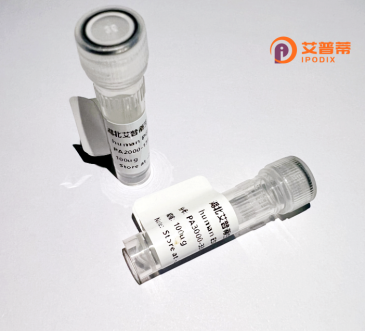
| 纯度 | >90%SDS-PAGE. |
| 种属 | Human |
| 靶点 | GPR171 |
| Uniprot No | O14626 |
| 内毒素 | < 0.01EU/μg |
| 表达宿主 | E.coli |
| 表达区间 | 1-319aa |
| 氨基酸序列 | MTNSSFFCPVYKDLEPFTYFFYLVFLVGIIGSCFATWAFIQKNTNHRCVSIYLINLLTAD FLLTLALPVKIVVDLGVAPWKLKIFHCQVTACLIYINMYLSIIFLAFVSIDRCLQLTHSC KIYRIQEPGFAKMISTVVWLMVLLIMVPNMMIPIKDIKEKSNVGCMEFKKEFGRNWHLLT NFICVAIFLNFSAIILISNCLVIRQLYRNKDNENYPNVKKALINILLVTTGYIICFVPYH IVRIPYTLSQTEVITDCSTRISLFKAKEATLLLAVSNLCFDPILYYHLSKAFRSKVTETF ASPKETKAQKEKLRCENNA |
| 分子量 | 36.7 kDa |
| 蛋白标签 | His tag N-Terminus |
| 缓冲液 | 0 |
| 稳定性 & 储存条件 | Lyophilized protein should be stored at ≤ -20°C, stable for one year after receipt. Reconstituted protein solution can be stored at 2-8°C for 2-7 days. Aliquots of reconstituted samples are stable at ≤ -20°C for 3 months. |
| 复溶 | Always centrifuge tubes before opening.Do not mix by vortex or pipetting. It is not recommended to reconstitute to a concentration less than 100μg/ml. Dissolve the lyophilized protein in distilled water. Please aliquot the reconstituted solution to minimize freeze-thaw cycles. |
以下是关于重组人GPR171蛋白的3篇代表性文献及其摘要:
1. **《Identification of GPR171 as a novel neuropeptide receptor involved in food intake》**
*作者:Lv C, et al. (2016)*
摘要:研究发现GPR171在中枢神经系统中广泛表达,并通过重组蛋白实验证明其可被特定神经肽激活,可能通过抑制cAMP信号通路调节摄食行为,提示其作为肥胖治疗的潜在靶点。
2. **《Structural insights into ligand recognition and activation of the human GPR171》**
*作者:Zhang Y, et al. (2020)*
摘要:利用冷冻电镜技术解析了重组人GPR171蛋白与其天然配体的复合物结构,揭示了配体结合口袋的关键氨基酸残基,为设计靶向GPR171的小分子药物提供了结构基础。
3. **《GPR171 regulates immune responses in macrophages through modulation of TNF-α production》**
*作者:Park SM, et al. (2018)*
摘要:通过重组GPR171蛋白体外实验,发现其在巨噬细胞中调控TNF-α的分泌,表明该受体在炎症及自身免疫疾病中可能具有免疫调节作用。
如需更详尽的文献,建议通过PubMed或Web of Science以“recombinant human GPR171”为关键词检索最新研究。
GPR171. a class A G protein-coupled receptor (GPCR), is an orphan receptor implicated in various physiological processes, including neuroregulation, appetite control, and energy homeostasis. Initially identified through genomic analysis, its endogenous ligand was later identified as BigLEN, a neuropeptide derived from proenkephalin. GPR171 interacts with Gi/o proteins, inhibiting cAMP signaling upon activation. Structurally, it features seven transmembrane domains characteristic of GPCRs and shares homology with purinergic and opioid receptors, though its precise activation mechanisms remain under investigation.
Recombinant human GPR171 protein is typically produced using mammalian expression systems (e.g., HEK293 cells) to ensure proper post-translational modifications and membrane localization. The protein is often engineered with tags (e.g., His-tag, FLAG-tag) for simplified purification and detection. Researchers utilize this recombinant form to study receptor-ligand interactions, downstream signaling pathways, and potential therapeutic applications. Emerging evidence links GPR171 dysfunction to neurological disorders (e.g., Parkinson's disease), metabolic syndromes, and cancer progression, positioning it as a novel target for drug discovery. Current studies focus on developing selective agonists/antagonists and elucidating its role in appetite regulation circuits, particularly in the hypothalamus. Its recombinant form also facilitates structural biology approaches like cryo-EM to resolve activation conformations.
×